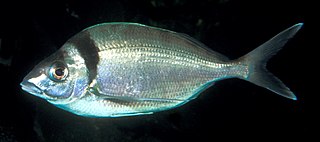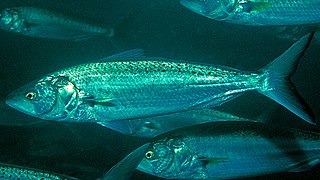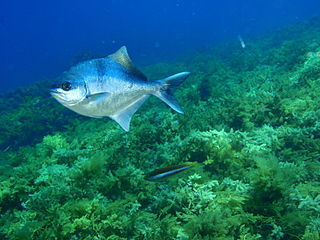Sea bass is a common name for a variety of different species of marine fish. Many fish species of various families have been called sea bass.
The pelagic zone consists of the water column of the open ocean and can be further divided into regions by depth. The word pelagic is derived from Ancient Greek πέλαγος (pélagos) 'open sea'. The pelagic zone can be thought of as an imaginary cylinder or water column between the surface of the sea and the bottom. Conditions in the water column change with depth: pressure increases; temperature and light decrease; salinity, oxygen, micronutrients all change. In a manner analogous to stratification in the Earth's atmosphere, the water column can be divided vertically into up to five different layers, with the number of layers depending on the depth of the water.

Demersal fish, also known as groundfish, live and feed on or near the bottom of seas or lakes. They occupy the sea floors and lake beds, which usually consist of mud, sand, gravel or rocks. In coastal waters, they are found on or near the continental shelf, and in deep waters, they are found on or near the continental slope or along the continental rise. They are not generally found in the deepest waters, such as abyssal depths or on the abyssal plain, but they can be found around seamounts and islands. The word demersal comes from the Latin demergere, which means to sink.

The porae, the grey morwong, blue morwong, butterfish, Douglas' morwong, Eastern blue morwong, great perch, queen snapper, rubberlip morwong or silver morwong, is a species of marine ray-finned fish, traditionally regarded as belonging to the family Cheilodactylidae, the members of which are commonly known as morwongs. It is found around south eastern Australia and the north eastern coast of the North Island of New Zealand at depths of about 10 to 100 metres, on sandy and rocky coasts.

Nemadactylus macropterus, the tarakihi, jackass morwong or deep sea perch, is a species of marine ray-finned fish, traditionally regarded as belonging to the family Cheilodactylidae, the members of which are commonly known as morwongs. It is found in the south western Pacific Ocean, in Australia and New Zealand. Although there are records from the southern Indian Ocean and southwestern Atlantic, these may be due to misidentifications of similar species.

Blue moki is a species of marine ray finned fish belonging to the family Latridae, the trumpeters. It is native to the southwestern Pacific Ocean around New Zealand and occasionally off southeastern Australia at depths of 10 metres (33 ft) and greater. Juveniles inhabit inshore waters, preferring rocky reefs while adults mostly occur in offshore waters forming schools over open bottoms. Some solitary adults can be found on reefs. This species can reach a length of 80 centimetres (31 in) FL, though most do not exceed 63 centimetres (25 in) TL. This species is commercially important and is also popular as a game fish.

Girella cyanea, also known as the blue drummer or Australian bluefish, is a species of sea chub native to inshore waters, around 6 metres (20 ft) depth, from Australia to New Zealand and the Kermadec Islands. Sightings were first recorded in 1881 but the species made its debut in scientific publications in 1919 in Theodore Roughly's Fishes of Australia and Their Technology.

Latridopsis forsteri, the bastard trumpeter, copper moki, red bastard trumpeter, red, white and silver bastard trumpeter, silver bastard trumpeter, silver trumpeter or white bastard trumpeter, is a species of marine ray finned fish belonging to the family Latridae, the trumpeters. It is native to the eastern Indian Ocean and southwestern Pacific Ocean. This species is commercially important.

Arripis trutta, known as the Australian salmon in Australia and as kahawai in New Zealand, is a South Pacific marine fish and one of the four extant species within the genus Arripis, native to the cooler waters around the southeastern Australian coasts and the New Zealand coastline. Other common names for this species include Eastern Australian salmon, bay trout, blackback salmon, buck salmon, cocky salmon, colonial salmon, woolley Judith, newfish and salmon trout.

The splendid sea perch, also called the rosy perch, Allport's groppo, Allport's perch, Southern goldie or Southern splendid perch is a species of marine ray-finned fish belonging to the family Callanthiidae. This fish is found off southern Australia and New Zealand.

Helicolenus percoides, the reef ocean perch, coral cod, coral perch, Jock Stewart, kuriarki, ocean perch, red gurnard perch, red gurnard scorpionfish, red ocean perch, red perch, red rock perch, scarpee or sea perch, is a species of marine ray-finned fish belonging to the subfamily Sebastinae, part of the family Scorpaenidae. It is found in the southwestern Pacific Ocean.

Cephalopholis urodeta, the darkfin hind, flagtail rockcod, chevron rockcod, duskyfin hind, duskyfin rockcod, flagtail grouper or V-tail grouper, is a species of marine ray-finned fish, a grouper from the subfamily Epinephelinae which is in the family Serranidae which also includes the anthias and sea basses. This fish occurs in the Western Pacific Ocean and the far eastern Indian Ocean.

Acanthurus guttatus, the whitespotted surgeonfish, spotted surgeonfish, mustard surgeonfish, mustard tang or spotband surgeonfish, is a species of marine ray-finned fish belonging to the family Acanthuridae, the surgeonfishes, unicornfishes or tangs. It is found in shallow waters on reefs in the Indo-Pacific.

Coastal fish, also called inshore fish or neritic fish, inhabit the sea between the shoreline and the edge of the continental shelf. Since the continental shelf is usually less than 200 metres (660 ft) deep, it follows that pelagic coastal fish are generally epipelagic fish, inhabiting the sunlit epipelagic zone. Coastal fish can be contrasted with oceanic fish or offshore fish, which inhabit the deep seas beyond the continental shelves.

Scorpaena papillosa, the red rock cod, Southern red scorpionfish, chained scorpionfish, common red gurnard, Southern red scorpioncod, Southern rockcod or dwarf scorpionfish, is a species of venomous marine ray-finned fish belonging to the family Scorpaenidae, the scorpionfishes.

The barber perch, also called the barber sea perch, red perch or Tasmanian barber, is endemic to Australia, found from southern Victoria to southwestern Western Australia, including Tasmania.

Caesioperca is a genus of ray-finned fish in the family Anthiadidae. It contains just two species, found in the ocean off Southern Australia and New Zealand.

Apolemichthys trimaculatus, the threespot angelfish or flagfin angelfish, is a demersal marine ray-finned fish, a marine angelfish belonging to the family Pomacanthidae. It has a wide Indo-Pacific distribution.

Callanthias australis, the magnificent sea perch, splendid perch, glorious groppo or Northern splendid perch, is a species of marine ray-finned fish belonging to the family Callanthiidae. This species is found in the southeastern Indian Ocean and the southwestern Pacific Ocean.

The sea sweep, also known as the maomao, snapjack, sweep is a species of marine ray-finned fish from the subfamily Scorpidinae of the sea chub family Kyphosidae. It is native to the southwestern Pacific Ocean from Australia to New Zealand.


















